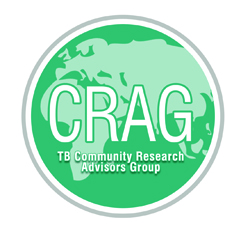
Community Research Advisors Group’s statement on the results of TBTC Study 35: an open-label, phase I/II dose finding and safety study of rifapentine and isoniazid in HIV- positive and HIV- negative children with latent tuberculosis infection
13 November 2024 — The Community Research Advisors Group (CRAG) celebrates both the findings and the methodology of Study 35, a phase I/II clinical trial of the tuberculosis (TB) preventive treatment regimen known as 3HP in children. Conducted by the Tuberculosis Trials Consortium (TBTC) at the U.S. Centers for Disease Control and Prevention, TBTC Study 35 results were presented today at the Union World Conference on Lung Health in Bali, Indonesia.
This trial — a dose-finding and safety study of rifapentine and isoniazid in children 0–12 years of age with tuberculosis infection, including both HIV-positive and HIV-negative children — represents a critical advancement for a demographic often overlooked in clinical research. When taken together once a week for 12 weeks, rifapentine and isoniazid are known as the 3HP regimen, which has become a preferred TB preventive treatment choice across the world. An earlier phase III clinical trial by the TBTC that published results over a decade ago demonstrated the efficacy and safety of 3HP in preventing TB in adults and children down to age 2 years of age. But until Study 35, data on the safety, tolerability, and right dose of 3HP in the youngest children were missing.
The results of the study are very positive. The study confirmed the safety of the 3HP regimen in children, as well as how to adapt doses of 3HP by weight (leaving behind an older, less precise method based only on age ranges), ensuring a better management of TB infection in children. These results are long awaited, with special emphasis on the ‘long.’ Though we celebrate the release of these results, the CRAG laments that the world had to wait so long for a study of 3HP dosing and safety in younger children and infants.
Study 35 also provides valuable insights into drug delivery in pediatric populations. Investigators were forward thinking in including qualitative research on the acceptability of 3HP from the perspective of children, caregivers, and healthcare workers. Additionally, the study will publish information on the bioavailability of rifapentine when mixed together with isoniazid as well as on the use of adult rifapentine tablets in suspension — information which will ease treatment options for children.
All of this allowed the World Health Organization to update its global guidelines on TB preventive treatment earlier this year to include information on effective and safe 3HP dosing down to age 0. Together with these data from Study 35, the recent availability of a child-friendly formulation of rifapentine, made by the generic manufacturer Lupin, brings us closer to the goal of ending TB in children.
“This study underscores the importance of inclusive, ethical, and rigorous research for all populations, especially those such as children who have been traditionally left out of clinical trials or made to wait years after data become available in adults. Identifying a safe, effective TB prevention strategy is especially important for children ages 0–1 who are at most risk of quickly developing serious forms of TB disease following exposure, including disseminated disease or TB meningitis,” said Barbara Seaworth, co-chair of the CRAG.
Dorothy Namutamba, CRAG co-chair, also calls on stakeholders to ensure access to treatment globally. “We hope that the 3HP regimen will be readily accessible to all children in countries in need and call for a modest price from the manufactures. Equitable access must go hand-in-hand with scientific progress.”
The TBTC has been advancing pediatric TB research for years, and this study is a further demonstration of its commitment to science that helps to advance the whole TB research field by leaving no-one behind. “We, the CRAG, hope that other research consortia will follow the TBTC’s lead and plan corresponding trials prioritizing key populations including children, people living with HIV, older adults, pregnant individuals, and other underrepresented groups. All populations deserve the benefits of scientific progress, and trials like Study 35 should become the rule, not the exception,” added Barbara Seaworth.
CRAG extends its gratitude to the TBTC, the trial leaders, and to everyone who contributed to this important work.
###
The Community Research Advisors Group (CRAG) is an international, community-driven advisory body that works to ensure the meaningful representation and engagement of affected communities in research conducted by the U.S. Centers for Disease Control and Prevention’s Tuberculosis Trials Consortium (TBTC). This group of research-literate activists and advocates supports a robust, comprehensive, and innovative TBTC research agenda that is responsive to community needs as well as scientific priorities. The CRAG is coordinated and hosted by Treatment Action Group.
